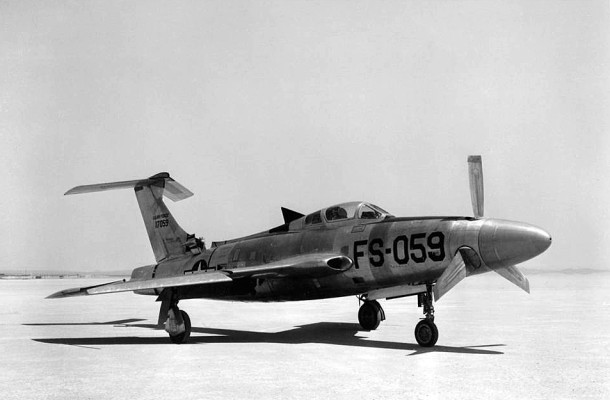
Sixty-four years ago this month, the USAF/Republic XF-84H experimental turboprop fighter took to the air on its maiden flight. The test sortie was flown at Edwards Air Force Base with Republic test pilot Henry G. “Hank” Beaird, Jr. at the controls.
The XF-84H was an experimental variant of Republic Aviation’s turbojet-powered F-84 Thunderstreak. An Allison XT40-A-1 turboprop engine, rated at 5,850 hp, served as the power source for this novel aircraft. The XT40 drove a variable-pitch, 3-blade, 12-foot diameter propeller at 3,000 rpm. Thrust level was changed by varying blade pitch.
Owing to its high rotational speed and large diameter, the outer 2 feet of the XF-84H propeller saw supersonic velocities. The shock waves that emanated from the prop produced a deafening wall of sound. The extreme sound level produced intense nausea and raging headaches in ground crewmen. As a result, the XF-84H was dubbed the Thunderscreech.
The prop wash from the aircraft’s powerful turboprop necessitated the use of a T-tail to keep the horizontal tail and elevator in clean air flow. The engine’s extreme torque was partially countered by differential deflection on the left and right wing flaps and by placement of the aircraft’s left wing root air intake a foot ahead of the its right intake.
A pair of XF-84H prototype aircraft (S/N 51-17059 and S/N 51-17060) was built by Republic Aviation. The inaugural flight of an XF-84H took place on Friday, 22 July 1955 at Edwards Air Force. This test hop, performed in Ship No. 1 (S/N 51-17059), was cut short by a forced landing.
A total of twelve (12) test flights were made in the two Thunderscreech prototypes; eleven (11) in Ship No. 1 and one (1) in Ship No. 2. Total flight time accumulated by these experimental airframes was 6 hours and 40 minutes. The majority of flights experienced forced landings for one reason or another.
The XF-84H suffered from reduced longitudinal stability and poor handling qualities. The aircraft was also plagued by frequent engine, hydraulic system, nose gear and vibration problems. Faced with the type’s obvious non-viability, USAF opted to cancel the XF-84H Program in September of 1956.
Historical records indicate that the XF-84H reached a top speed of 520 mph during its brief flight test life. This figure was a full 120 mph short of the aircraft’s design speed. Nonetheless, the XF-84H held the speed record for single-engine prop-driven aircraft until Monday, 21 August 1989. On that date, a specially modified Grumman F8F Bearcat established the existing record of 528.33 mph.
